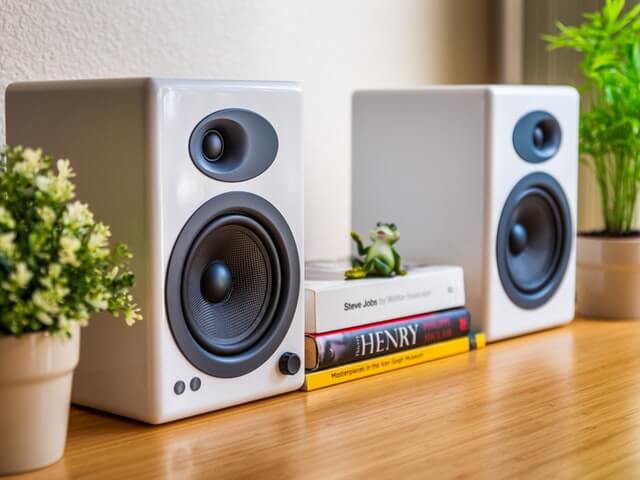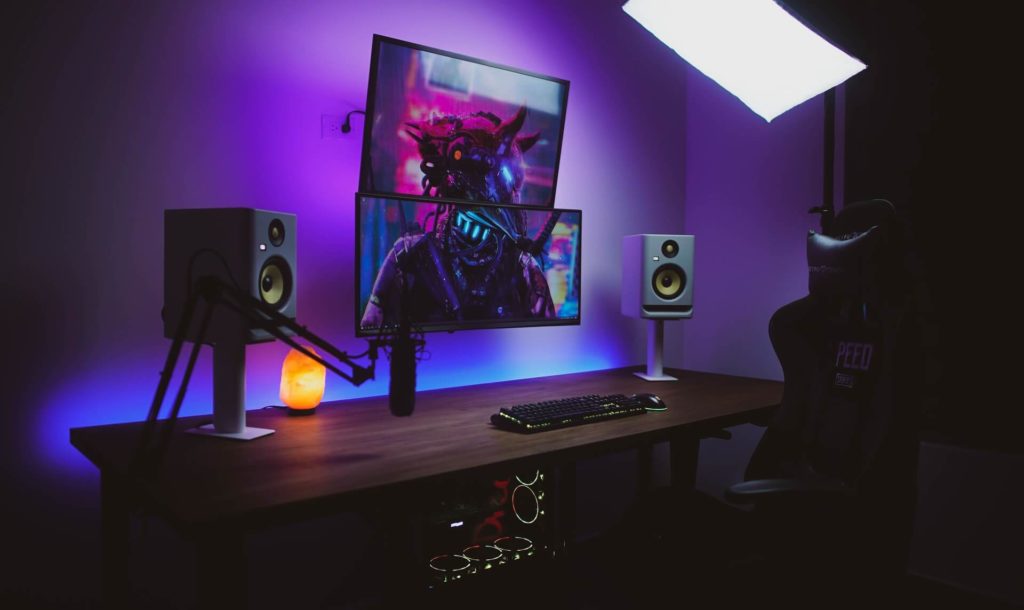We often get asked if bookshelf speakers can be placed sideways. The answer isn’t straightforward. We’ll break down why and explain the possible impacts.
Table of Contents
Can You Put Bookshelf Speakers On Their Side?
Yes. Bookshelf speakers can be placed on their side, but it’s not ideal. It is possible that sound quality will be negatively impacted. While horizontal positioning is not optimal, it might be fine if your purpose is casual listening.
Placing bookshelf speakers sideways is not optimal for sound quality for movies or music. We understand that horizontal positioning is not always possible though. Other factors might make it difficult. Lack of space is often the reason. Some might prefer the way it looks in a particular room.
It is best to try listening to music with your bookshelf speakers in both positions. This will allow you to find out if the horizontal placement will severely affect would quality. This is especially important if you want the best sound from your speakers. The difference might not matter to those who are fine with the tradeoff.
What Happens If I Place Bookshelf Speakers Sideways?
You might be wondering why placing bookshelf speakers on their side may not be the best option. It does make a difference for a listener who wants the best music and home theater experience. Here are a few reasons why.
Tweeter May Not Be At Ear Level
There is a good reason vertical speakers are the norm. Ideally, the tweeters on your bookshelf speakers should be at ear level when you’re at your preferred listening position. This is the sweet spot for the placement of most loudspeakers to get optimal sound quality. This is harder to accomplish with horizontal placement.
Stereo Imaging Can Suffer
Stereo imaging is crucial to both critical listening and audio production. Placing bookshelf speakers on their sides is not how speakers drivers are intended to function. If placed horizontally, the tweeter and bass driver can end up distributing sound waves unevenly. This can mean muddled or wonky stereo imaging. This impacts midrange, high, and bass frequencies. The end result is sound reproduction that is inaccurate. Speakers designed for vertical placement rely on vertical dispersion. Horizontal placement makes this difficult.
No Airflow or Cooling
Powered or active bookshelf speakers are fitted with heat sinks positioned at their rear. These heat sinks are designed to push air vertically to keep the speakers cool. Airflow can be impacted when you lay bookshelf speakers horizontally. This can lead to thermal issues which can wreak havoc on audio equipment.
Where Are Bookshelf Speakers Placed?

Bookshelf speakers can be placed in different places. Here are some examples of some of the locations where they can be kept:
Speakers Stands
Bookshelf speakers can be kept on regular speaker stands. Speaker stands actually offer better flexibility than bookshelves, especially if they are adjustable. You can easily move the speaker stands around as you aim for the most optimal speaker placement.
Furniture (TV Stand, Bookshelf, etc)
You can lay bookshelf speakers on bookshelves (of course), TV stands, or coffee tables. You can actually place these speakers on any stable, flat surface. Not all locations will be equally appropriate or efficient. It’s still best to experiment and find out what works best.
Mount to Wall
Mounting speakers is another way to position your bookshelf speakers. This method will not work for all scenarios, but it’s another good option. The mounting process is more involved and therefore it’s not the most convenient option. It’s ideal for people with limited floor space though.
Mounted speakers work equally well for front and rear speakers. Mounted speakers are more popular in home theater setups. Finding floor space in a room can be a little hard with 5+ speakers. Mounting may not sound bad if you have front speakers, rear speakers, a center channel, surround speakers, and a subwoofer.
Other Bookshelf Speaker Placement Tips

Here are a few tips that can help you improve the performance of your bookshelf speakers. These tips can help you avoid mistakes that are common when people place bookshelf speakers.
Place At Correct Height (tweeter at ear level)
Yes, this is coming up again since can make a difference in sound quality. Ensure that any loudspeakers are placed with their tweeters at your ear level while seated. This is true whether we’re talking front speakers, surround speakers, music, studio monitors, or movies. Having the tweeter level with your ears will result in the best audio experience and stereo imaging. If necessary, you can even adjust the speaker angle to achieve this.
Remove Obstructions Between Speaker and Listening Position
This should be pretty obvious. Ideally, your bookshelf speaker should be positioned about 4 to 5 feet in distance from your listening position. This space between your ears and the bookshelf speakers should be obstruction-free. There should be a free line of contact from the speakers to your ears. Obstructions and other room acoustics can impact what you hear more than most people realize.
Don’t Place Too Close To Wall
The ideal distance for a bookshelf speaker to be positioned is 2 to 3 feet from a wall. Low frequencies will be exaggerated if you place bookshelf speakers too close. When this happens, your mid and high frequencies become lost in the audio mix. The result is a bookshelf speaker with an uneven frequency response.
We all love to listen to big and deep bass. You also don’t want a bloated bass response and muddy sound quality. Take time to plan out where you place your speakers. You want a balanced frequency response and sound quality that’s not colored by room acoustics.
Conclusion
Having bookshelf speakers on their side can impact sound quality. The best position for your bookshelf speakers is upright. Vertical speakers should be placed vertically for the best listening experience. This allows for optimal vertical dispersion and stereo imaging. That’s not to say some won’t be fine with the difference. Horizontal positioning may not be a big deal for casual listening.
It is a big deal for critical listening where the accuracy of audio is important. Horizontal bookshelf speakers or studio monitors would be an issue if you are a music producer. You will want to monitor your audio mix closely for production purposes. That requires audio equipment with accurate sound reproduction. Having your speakers on their sides will make this more difficult.

Keith Collins has been writing for over 15 years for various publications. He’s a lover of music, home theater, and excellent sound quality. His fondness for technology in addition to his non-stop curiosity fuels his writing ventures.






